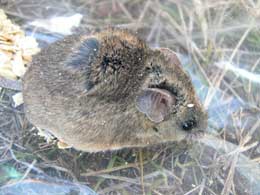Effects of Restoration
on Small Mammals
Monitoring Objectives
In the spring of 2004 we commenced a long-term study that examines effects of coastal sage scrub restoration on small mammals. The goal of our sampling effort is to produce estimates of small mammal species composition, richness, diversity, abundance, and density over the course of habitat restoration, beginning at baseline (before thistle removal) through at least five years after restoration begins or until the small mammal communities resemble those found in our reference sites (pristine coastal sage scrub).
Methods
 Trapping is conducted twice per year (every 6 months) for three consecutive nights. As of January 2007 there are two trapping areas, each of which consists of a pair of sites. One site is an artichoke thistle-invaded stand undergoing restoration and the other is composed of pristine coastal sage scrub. These paired sites have been closely matched in respect to physical characteristics such as aspect, slope degree, and soil phase. Each restoration and pristine site contains a 3 x 11 trap grid containing 33 non-collapsible Sherman traps spaced 4m apart. Traps are baited with a mixture of rolled oats and peanut butter in the late afternoon and checked shortly after sunrise. Captured mammals are identified, weighed, and marked at the base of their tail prior to release. Trapping is conducted during periods of intermediate moonlight.
Trapping is conducted twice per year (every 6 months) for three consecutive nights. As of January 2007 there are two trapping areas, each of which consists of a pair of sites. One site is an artichoke thistle-invaded stand undergoing restoration and the other is composed of pristine coastal sage scrub. These paired sites have been closely matched in respect to physical characteristics such as aspect, slope degree, and soil phase. Each restoration and pristine site contains a 3 x 11 trap grid containing 33 non-collapsible Sherman traps spaced 4m apart. Traps are baited with a mixture of rolled oats and peanut butter in the late afternoon and checked shortly after sunrise. Captured mammals are identified, weighed, and marked at the base of their tail prior to release. Trapping is conducted during periods of intermediate moonlight.
Results

-
Abundance Richness Area 1 Area 1 Area 2 Area 2 Biomass Composition of Pristine Sites Area 1 Area 1 Area 2 Area 2 Composition of Restoration Sites Area 1 Area 2
 Summary
Summary
As the restoration efforts in our two monitoring areas are still in their early stages, we have not yet observed the complete re-establishment of small mammal communities. However, the recent increase in species diversity at our oldest restoration site is very encouraging. It is our hope that as native vegetation continues to spread throughout restoration areas and the percentage of ground cover increases, small mammal populations in restoration sites will eventually approximate those in matched pristine sites.
An additional concern is the overall decreasing trend we have observed in the abundance, richness, and biomass of small mammals in the pristine coastal sage scrub sites. We will continue to monitor these areas to determine whether this is a cyclic phenomenon or a more serious downtrend in native small mammal populations. In the winter of 2007, we added a third monitoring area to this project.
Special Thanks to:
Stephen Bennet: Orange County Vector Ecologist
Our volunteer field assistants: Barbara Bruce, Debbie Gley, Stacee Lockard, Zehava Parim-Adimor, John Perron, David Skinner
How to Get Involved:
Contact the Assistant Director of Research and Education
Scott Gibson
100 Bell Canyon Rd. Trabuco Canyon, CA 92679
949-858-0309; Scott Gibson
